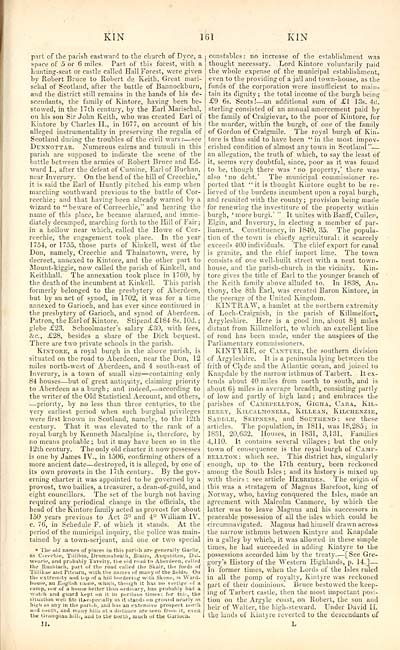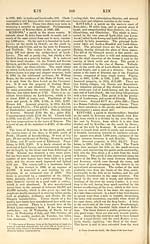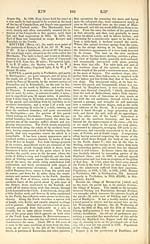Topographical, statistical, and historical gazetteer of Scotland > Volume 2
(173) Page 161
Download files
Complete book:
Individual page:
Thumbnail gallery: Grid view | List view

KIN
161
KIN
part of the parish eastward to the church of Dyce, a
space of 5 or 6 miles, Part of this forest, with a
hunting-seat or castle called Hall Forest, were given
by Robert Bruce to Robert de Keith, Great mari-
schal of Scotland, after the battle of Bannockburn,
and the district still remains in the hands of his de-
scendants, the family of Kintore, having been be-
stowed, in the 17th century, by the Earl Marischal,
on his son Sir John Keith, who was created Earl of
Kintore by Charles II., in 1677, on account of his
alleged instrumentality in preserving the regalia of
Scotland during the troubles of the civil warsr — see
Duxnottar. Numerous cairns and tumuli in this
parisli are supposed to indicate the scene of the
battle between the armies of Robert Bruce and Ed-
ward I., after the defeat of Cumine, Earl of Buchan,
near Inverury. On the head of the hill of Creechie,*
it is said the Earl of Huntly pitched his camp when
inarching southward previous to the battle of Cor-
reechie; and that having been already warned by a
wizard to "beware of Correecbie," and hearing the
name of this place, he became alarmed, and imme-
diately decamped, marching forth to the Hill of Fair;
in a hollow near which, called the Howe of Cor-
reechie, the engagement took place. In the year
1754, or 1755, those parts of Kinkell, west of the
Don, namely, Creechie and Thainstown, were, by
decreet, annexed to Kintore, and the other part to
Mount-kiggie, now called the parish of Kinkell, and
Keithhall. The annexation took place in 1760, by
the death of the incumbent at Kinkell. This parish
formerly belonged to the presbytery of Aberdeen,
but by an act of synod, in 1702, it was for a time
annexed to Garioch, and has ever since continued in
the presbytery of Garioch, and synod of Aberdeen.
Patron, the Earl of Kintore. Stipend £184 8s. 10d.;
glebe £23. Schoolmaster's salary £30, with fees,
&c, £28, besides a share of the Dick bequest..
There are two private schools in the parish.
Kintore, a royal burgh in the above parish, is
situated on the road to Aberdeen, near the Don, 12
miles north-west of Aberdeen, and 4 south-east of
Inverury, is a town of small size — containing only
84 houses — but of great antiquity, claiming priority
to Aberdeen as a burgh; and indeed, — according to
the writer of the Old Statistical Account, and others,
— priority, by no less than three centuries, to the
very earliest period when such burghal privileges
were first known in Scotland, namely, to the 12th
century. That it was elevated to the rank of a
royal burgh by Kenneth Macalpine is, therefore, by
no means probable ; but it may have been so in the
12th century. The only old charter it now possesses
is one by James IV., in 1506, confirming others of a
more ancient date — destroyed, it is alleged, by one of
its own provosts in the 17th century. By the gov-
erning charter it was appointed to be governed by a
provost, two bailies, a treasurer, a dean-of-guild, and
eight councillors. The set of the burgh not having
required any periodical change in the officials,, the
head of the Kintore family acted as provost for about
150 years previous to Act 3° and 4° William IV.
c. 76, in Schedule F. of which it stands. At the
period of the municipal inquiry, the police was main-
tained by a town-serjeant, and one or two special
* Tile old names of places in tliis parish are generally Gaelic,
as Cieechie, Tilliliin, Drumnaheath, Blairs, Anqwhiten, Dal-
wenrie, and probably Tavelty, the uid road to Aberdeen, called
the Rushlach, part of the road called the Skair, the fords of
Tillikae and Pitcurn, with the names of many of the fields. On
the extremity and top of a hill bordering with Skene, is Ward-
house, an English name, which, though it has no vestige of a
camp, nor of a house better than ordinary, has probably had a
watch and guard kept on it in perilous times: for this, the
situation well tits it^especially as it stands on ground nearly as
high as any in the pariah, and lias an extensive prospect north
and south, and many hills at a distance are seen froin it, even
the Grampian lulls, and to the north, much of the Gariuch.
II.
constables; no increase of the establishment was
thought necessary. Lord Kintore voluntarily paid
the whole expense of the municipal establishment,
even to the providing of a jail and town-house, as the
funds of the corporation were insufficient to main-
tain its dignity ; the total income of the burgh being
£9 6s. Scots! — an additional sum of £1 13s. 4il.
sterling consisted of an annual amercement paid by
the family of Craigievar, to the poor of Kintore, for
the murder, within the burgb, of one of the family
of Gordon of Craigmile. The royal burgh of Kin-
tore is thus said to have been " in the most impov-
erished condition of almost any town in Scotland" —
an allegation, the truth of which, to say the least of
it, seems very doubtful, since, poor as it was found
to be, though there was 'no property,' there was
also 'no debt.' The municipal commissioner re-
ported that " it is thought Kintore ought to be re-
lieved of the burdeDS incumbent upon a royal burgh,
and reunited with the county; provision being marie
for renewing the investiture of the property within
burgh, ' more burgi.' " It unites with Banff, Ctillen,
Elgin, and Inverury, in electing a member of par-
liament. Constituency, in 1840,35. The popula-
tion of the town is chiefly agricultural:, it scarcely
exceeds 400 individuals. The chief export for canal
is granite, and the chief import lime. The town
consists of one well-built street with a neat town-
house, and the parish-church in the vicinity. Kin-
tore gives the title of Earl to the younger branch of
the Keith family above alluded to. In 1838, An-
thony, the Sth Earl, was created Baron Kintore, in
the peerage of the United Kingdom.
KIXTRAW, a hamlet at the northern extremity
of Loch-Craignish, in the parish of Killmelfort*
Argyleshire. Here is a good inn, about 8A miles
distant from Killmelfort, to which an excellent line
of road has been made, under the auspices of the
Parliamentary commissioners.
KINTYRE, or Can-tyre, the southern division
of Argyleshire. It is a peninsula lying between the
frith of Clyde and the Atlantic ocean, and joined to
Knapdale by the narrow isthmus of Tarbert. It ex-
tends about 40 miles from north to south, and is.
about 6| miles in average breadth,, consisting partly
of low and partly of high land ; and embraces the
parishes of Cambpellton, Gigha, Cara, Kil-
BERRY, KlLCALMONELL, KlLLEAN, KlLCHENZIE,.
Saddle, Skipness, and Southend t see these
articles. The population, in 1811, was 18,285; in
1831, 20,632. Houses, in 1831, 3,131. Families
4,110. It contains several villages; but the only
town of consequence is the royal burgh of Camp-
bellton : which see. This district has, singularly
enough, up to the 17th century,, been reckoned
among the South Isles ; and its history is mixed up
with theirs t see article Hebrides. The origin of
this was a stratagem of Magnus Barefoot, king of
Norway, who, having conquered the Isles, made an
agreement with Malcolm Canmore, by which the
latter was to leave Magnus and his successors in
peaceable possession of all the isles which could be
circumnavigated. Magnus had himself drawn across
the narrow isthmus between Kintyre and Knapdale
in a galley by which, it was allowed in these simple
times, he had succeeded in adding Kintyre to the
possessions accorded him by the treaty [See Gre-
gory's History of the Western Highlands, p. 14.] — .
In former times, when the Lords of the Isles ruled
in all the pomp of royalty, Kintyre was reckoned
part of their dominions. Bruce bestowed the keep-
ing of Tarbert castle, then the most important posi-
tion on the Argyle coast, on Robert, the son and
heir of Walter, the high-steward. Under David II.
the lands of Kintyre reverted to the descendants of
161
KIN
part of the parish eastward to the church of Dyce, a
space of 5 or 6 miles, Part of this forest, with a
hunting-seat or castle called Hall Forest, were given
by Robert Bruce to Robert de Keith, Great mari-
schal of Scotland, after the battle of Bannockburn,
and the district still remains in the hands of his de-
scendants, the family of Kintore, having been be-
stowed, in the 17th century, by the Earl Marischal,
on his son Sir John Keith, who was created Earl of
Kintore by Charles II., in 1677, on account of his
alleged instrumentality in preserving the regalia of
Scotland during the troubles of the civil warsr — see
Duxnottar. Numerous cairns and tumuli in this
parisli are supposed to indicate the scene of the
battle between the armies of Robert Bruce and Ed-
ward I., after the defeat of Cumine, Earl of Buchan,
near Inverury. On the head of the hill of Creechie,*
it is said the Earl of Huntly pitched his camp when
inarching southward previous to the battle of Cor-
reechie; and that having been already warned by a
wizard to "beware of Correecbie," and hearing the
name of this place, he became alarmed, and imme-
diately decamped, marching forth to the Hill of Fair;
in a hollow near which, called the Howe of Cor-
reechie, the engagement took place. In the year
1754, or 1755, those parts of Kinkell, west of the
Don, namely, Creechie and Thainstown, were, by
decreet, annexed to Kintore, and the other part to
Mount-kiggie, now called the parish of Kinkell, and
Keithhall. The annexation took place in 1760, by
the death of the incumbent at Kinkell. This parish
formerly belonged to the presbytery of Aberdeen,
but by an act of synod, in 1702, it was for a time
annexed to Garioch, and has ever since continued in
the presbytery of Garioch, and synod of Aberdeen.
Patron, the Earl of Kintore. Stipend £184 8s. 10d.;
glebe £23. Schoolmaster's salary £30, with fees,
&c, £28, besides a share of the Dick bequest..
There are two private schools in the parish.
Kintore, a royal burgh in the above parish, is
situated on the road to Aberdeen, near the Don, 12
miles north-west of Aberdeen, and 4 south-east of
Inverury, is a town of small size — containing only
84 houses — but of great antiquity, claiming priority
to Aberdeen as a burgh; and indeed, — according to
the writer of the Old Statistical Account, and others,
— priority, by no less than three centuries, to the
very earliest period when such burghal privileges
were first known in Scotland, namely, to the 12th
century. That it was elevated to the rank of a
royal burgh by Kenneth Macalpine is, therefore, by
no means probable ; but it may have been so in the
12th century. The only old charter it now possesses
is one by James IV., in 1506, confirming others of a
more ancient date — destroyed, it is alleged, by one of
its own provosts in the 17th century. By the gov-
erning charter it was appointed to be governed by a
provost, two bailies, a treasurer, a dean-of-guild, and
eight councillors. The set of the burgh not having
required any periodical change in the officials,, the
head of the Kintore family acted as provost for about
150 years previous to Act 3° and 4° William IV.
c. 76, in Schedule F. of which it stands. At the
period of the municipal inquiry, the police was main-
tained by a town-serjeant, and one or two special
* Tile old names of places in tliis parish are generally Gaelic,
as Cieechie, Tilliliin, Drumnaheath, Blairs, Anqwhiten, Dal-
wenrie, and probably Tavelty, the uid road to Aberdeen, called
the Rushlach, part of the road called the Skair, the fords of
Tillikae and Pitcurn, with the names of many of the fields. On
the extremity and top of a hill bordering with Skene, is Ward-
house, an English name, which, though it has no vestige of a
camp, nor of a house better than ordinary, has probably had a
watch and guard kept on it in perilous times: for this, the
situation well tits it^especially as it stands on ground nearly as
high as any in the pariah, and lias an extensive prospect north
and south, and many hills at a distance are seen froin it, even
the Grampian lulls, and to the north, much of the Gariuch.
II.
constables; no increase of the establishment was
thought necessary. Lord Kintore voluntarily paid
the whole expense of the municipal establishment,
even to the providing of a jail and town-house, as the
funds of the corporation were insufficient to main-
tain its dignity ; the total income of the burgh being
£9 6s. Scots! — an additional sum of £1 13s. 4il.
sterling consisted of an annual amercement paid by
the family of Craigievar, to the poor of Kintore, for
the murder, within the burgb, of one of the family
of Gordon of Craigmile. The royal burgh of Kin-
tore is thus said to have been " in the most impov-
erished condition of almost any town in Scotland" —
an allegation, the truth of which, to say the least of
it, seems very doubtful, since, poor as it was found
to be, though there was 'no property,' there was
also 'no debt.' The municipal commissioner re-
ported that " it is thought Kintore ought to be re-
lieved of the burdeDS incumbent upon a royal burgh,
and reunited with the county; provision being marie
for renewing the investiture of the property within
burgh, ' more burgi.' " It unites with Banff, Ctillen,
Elgin, and Inverury, in electing a member of par-
liament. Constituency, in 1840,35. The popula-
tion of the town is chiefly agricultural:, it scarcely
exceeds 400 individuals. The chief export for canal
is granite, and the chief import lime. The town
consists of one well-built street with a neat town-
house, and the parish-church in the vicinity. Kin-
tore gives the title of Earl to the younger branch of
the Keith family above alluded to. In 1838, An-
thony, the Sth Earl, was created Baron Kintore, in
the peerage of the United Kingdom.
KIXTRAW, a hamlet at the northern extremity
of Loch-Craignish, in the parish of Killmelfort*
Argyleshire. Here is a good inn, about 8A miles
distant from Killmelfort, to which an excellent line
of road has been made, under the auspices of the
Parliamentary commissioners.
KINTYRE, or Can-tyre, the southern division
of Argyleshire. It is a peninsula lying between the
frith of Clyde and the Atlantic ocean, and joined to
Knapdale by the narrow isthmus of Tarbert. It ex-
tends about 40 miles from north to south, and is.
about 6| miles in average breadth,, consisting partly
of low and partly of high land ; and embraces the
parishes of Cambpellton, Gigha, Cara, Kil-
BERRY, KlLCALMONELL, KlLLEAN, KlLCHENZIE,.
Saddle, Skipness, and Southend t see these
articles. The population, in 1811, was 18,285; in
1831, 20,632. Houses, in 1831, 3,131. Families
4,110. It contains several villages; but the only
town of consequence is the royal burgh of Camp-
bellton : which see. This district has, singularly
enough, up to the 17th century,, been reckoned
among the South Isles ; and its history is mixed up
with theirs t see article Hebrides. The origin of
this was a stratagem of Magnus Barefoot, king of
Norway, who, having conquered the Isles, made an
agreement with Malcolm Canmore, by which the
latter was to leave Magnus and his successors in
peaceable possession of all the isles which could be
circumnavigated. Magnus had himself drawn across
the narrow isthmus between Kintyre and Knapdale
in a galley by which, it was allowed in these simple
times, he had succeeded in adding Kintyre to the
possessions accorded him by the treaty [See Gre-
gory's History of the Western Highlands, p. 14.] — .
In former times, when the Lords of the Isles ruled
in all the pomp of royalty, Kintyre was reckoned
part of their dominions. Bruce bestowed the keep-
ing of Tarbert castle, then the most important posi-
tion on the Argyle coast, on Robert, the son and
heir of Walter, the high-steward. Under David II.
the lands of Kintyre reverted to the descendants of
Set display mode to: Large image | Transcription
Images and transcriptions on this page, including medium image downloads, may be used under the Creative Commons Attribution 4.0 International Licence unless otherwise stated. ![]()
| Gazetteers of Scotland, 1803-1901 > Topographical, statistical, and historical gazetteer of Scotland > Volume 2 > (173) Page 161 |
|---|
| Permanent URL | https://digital.nls.uk/97450666 |
|---|
| Description | Volume second: I-Z. |
|---|---|
| Shelfmark | Map Room Ref.2 |
| Attribution and copyright: |
|

